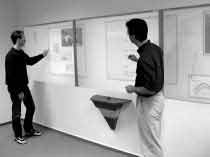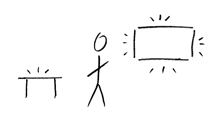| back to index | |||
H8 Augmented Reality * |
|||
 The DynaWall environment [Streitz et al., 1999]. |
|||
|
...you are designing an interactive exhibit, and have to decide
whether to structure your contents into a logical information
hierarchy - Flat And Narrow Tree, or use
an approach that creates an immersive experience in which the
information structure is not the primary dimension.
|
|||
|
* * *
|
|||
| On the one hand, interactive exhibits generally aim to
convey an innovative experience. On the other hand, they have to
relate to the corpus of real experiences users already have, to be
easy to understand.
|
|||
| DynaWall |
The DynaWall project shown in the opening picture [Streitz et al., 1999] uses a series of interactive whiteboards to create a large touch-sensitive "electronic wall" where users can work with large information structures collaboratively. It does not require anybody to enter a virtual environment. Instead, it resembles a standard chalk board arrangement, but augments this infrastructure with the advantages and added possibilities of an interactive computer display. |
||
| Virtual Vienna city tour |
The Virtual Vienna city tour uses the metaphor of a real city tour to become easier to understand for visitors at first sight. Users do not browse an artificial information space like a web document network, or put on a VR helmet which would only add to preparation time, and reduce visitor throughput and possible cooperation. Instead, they start out as on a real city tour, beginning with a panoramic view on a large projection before them, of one of the important places in the city. This spatial city tour metaphor always remains the main metaphor for using the system. Information about objects of interest in the current place is displayed by moving towards those objects, which brings up a short explanation about them. To move to a different panorama, users can follow direction arrows displayed within the 3-D view. |
||
| NaviPad |
Users navigate by moving a NaviPad, a console comparable to a flight stick, but with two handles, with their hands to turn around, look up and down, and move towards or away from objects in the scene. As in a real tour, practically their entire viewing field is filled with this photorealistic panorama. Only if they wish to get an overview of the city's geography, and a sense where they are in the city, they can have a look at an LCD panel between their hands with a map. This situation is very similar to walking through a city with a real map in your hands. Of course, the interactive technology makes the digital map more useful in some respects. For example, to move to a distant part of the city, users do not have to walk through all the panoramas on the way, but can jump directly to the point of interest by touching it on the map. |
||
| Ubiquitous and Pervasive Computing |
The entire research direction of ubiquitous and pervasive computing aims at a similar experience: users are not taken into a virtual reality in which real experiences can only be recreated inadequately. Instead, their real environment is augmented by unobtrusive, ubiquitous, intelligent technology, systems and applications that, for example, add active markers to books, remind the user of errands when he passes a shop, etc. [Russell and Weiser, 1998]. |
||
|
Therefore: In situations where your system aims to recreate a real experience, use as much real instead of virtual environment as possible. Instead of trying to recreate all aspects of reality inside an artificial environment, augment the real environment with interactive technology that is not usually available otherwise. |
|||
 |
|||
|
* * *
|
|||
|
Augmented reality works the better, the less obtrusive
and visible the actual technology is - Invisible Hardware. |
|||
This pattern is taken from the book "A Pattern Approach to Interaction Design" (PAID) by Jan Borchers (John Wiley and Sons, Chichester, UK, 2001). Copyright 2001 John Wiley and Sons. Used by permission. See http://media.informatik.rwth-aachen.de/paid.html for more information. Online version by Susan Babutzka, ETH Zurich (subabutz_at_student.ethz.ch). |
|||